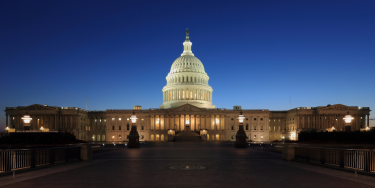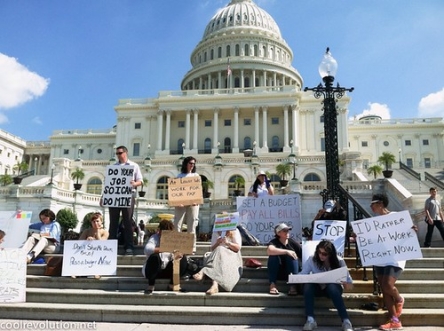
Stopgap funding measure signed by President Trump; California’s Senators voted no
By G. A. McNeeley
March 18 2025 (Washington D.C.) — Congress avoided a government shutdown on March 14, just a few hours before the funding deadline. The stopgap measure to fund the government until September 30 was signed by President Donald Trump on Saturday.
The stopgap would fund government operations through the remainder of this fiscal year, but it would also slash non-defense funding by roughly $13 billion and increase defense spending by about $6 billion over current budgets (including billions for deportations, veterans’ health care and the military).
Many Democrats, including California’s Senators Adam Schiff and Alex Padilla, opposed the measure due to the non-defense cuts and because Republicans refused to include language in the bill putting guardrails on Trump and Elon Musk’s ability to continue dismantling the federal bureaucracy unchecked. The Democrats also advocated for a shorter, four-week stopgap to keep the government running on current funding levels in an effort to buy more time for appropriators to strike a deal on a bipartisan funding package. Republican leadership interest in those negotiations diminished weeks ago.
Senate Minority Leader Chuck Schumer blocked filibuster
Senate Democrats came under intense pressure to oppose the Trump-backed bill. Now Senate Minority Leader Chuck Schumer, and nine others, are facing backlash after they helped clear a path for its passage by refusing to support a filibuster to block the budget bill.
Lawmakers raced towards a shutdown that would’ve had far-reaching consequences across the federal government, highlighting the struggle Democrats face, trying to counter Trump and the Republican control on power in Washington.
Schumer and nine other Democrats crossed the aisle to advance the budget in a key procedural vote. The legislation only required a simple majority in the Senate chamber for final passage, and all but two of those ten ultimately voted no on the budget bill.
Schumer argued his party only had bad options. “I believe it is the best way to minimize the harm that the Trump administration will do to the American people,” Schumer told CNN, in defense of his vote. “Clearly, this is a Hobson's choice. The CR (continuing resolution) is a bad bill, but as bad as the CR is, I believe allowing Donald Trump to take even much more power via a government shutdown is a far worse option.”
Since Congress has not approved appropriations for any federal departments, all would be affected. Every agency has its own set of plans for a shutdown. Those plans include how many employees would be laid-off, which employees are considered essential and would work without pay, how long it would take to wind down operations in the hours before a shutdown and which activities would come to a halt. Those plans can vary from shutdown to shutdown.
The impact of a shutdown differs each time, and it’s unclear how agencies would handle it now, especially since Trump’s efforts to downsize the federal government has wreaked havoc on their operations and workforces.
The Division Among Party Members
Trump praised Schumer for saying he would support the measure, telling reporters after the vote, “I appreciate Senator Schumer, and I think he did the right thing, really. I’m very impressed by that.”
Many Senate Democrats and House Democrats saw the vote as a surrender in the party’s first real leverage point in Trump’s second term.
The initial vote had been closely watched by Democrats across the country, who saw it as a test of their party leaders’ willingness to fight Trump.
Ultimately, the Senate voted 54-46 to approve the stopgap bill for government funding through September 30. The vote was mostly party line, though Senator Jeanne Shaheen (New Hampshire Democrat) and Angus King (Maine independent who caucuses with Democrats) voted in favor of the bill, while Senator Rand Paul of Kentucky (Republican) opposed it.
“Once I had voted for cloture, it was an opportunity to pass the bill, and I thought it was more honest to vote for it,” Shaheen told CNN. “I thought, much as I didn’t like the CR, I thought a government shutdown would be worse and would give Trump and Elon Musk and the DOGE operation more of an opportunity to fire people, to shut down agencies and to close the work of the government.”
At the urging of Democrats like Representative Alexandria Ocasio-Cortez, voters had been flooding senators’ offices with calls urging them to block the bill and take on Trump for his dismantling of the federal government. Many Democrats believe that Schumer failed that test.
Schumer has faced criticism, but no senators have publicly said they would challenge his leadership.
House Democrats, including House Minority Leader Hakeem Jeffries, were against the bill, but lost by one vote from one of their members. It was not enough to sink the bill, which passed the House on March 11th.
Jeffries would not answer when asked whether he had lost confidence in Schumer, with whom he diverged on the funding issue.
Senate Democrats are now grappling with how to move forward as a caucus after the government funding bill split their party.
Schumer told CNN’s Jake Tapper that he “always knew there would be disagreements,” but maintained that a “government shutdown would be far worse” than voting for the GOP-led measure.
“My job as leader is to lead the party and if there’s going to be danger in the near future, to protect the party. And I’m proud I did it, I knew I did the right thing, and I knew there would be some disagreements. That’s how it always is,” he added.
Schumer also defended his leadership position, saying, “My caucus and I are in sync.”
New Mexico Senator Martin Heinrich would not say whether he thought the party needed a new leader, telling reporters, “That’s a conversation for inside the caucus. I’m not going to debate that out here.”
Virginia Senator Mark Warner said he has “faith in Chuck Schumer,” but acknowledged that the caucus had a “choppy week.”
“I voted no on the CR. I heard that overwhelmingly from folks, and again, recognizing I got tons of federal workers. But I have total respect for the folks who reached another conclusion, and the idea that they would have had a shutdown that would have put us into the abyss with, unfortunately, parts of this administration, doesn’t follow the law,” he told CNN.
“I think the Democrats need to have a pro-growth agenda that recognizes fairness, and that is, frankly, not the debate though, that we just took place. That we just took place, it was two awful choices,” he added.
What California Politicians Have To Say
California Senator Alex Padilla issued the following statement after the House of Representatives narrowly passed a continuing resolution to fund the government through September 30th:
“The House Republican spending bill completely shortchanges California and other disaster-stricken states on disaster relief. We cannot leave communities in our states behind as they continue to rebuild and recover from devastating recent disasters. Despite the House vote today, I still believe the best path forward is for Congress to instead pass a 30-day funding bill to keep the government open while we continue negotiations for the remainder of the fiscal year in a way that properly funds disaster relief and doesn’t cede more power to Trump and Elon Musk.”
California Senator Adam Schiff explained why he’s “voting no, and why this needs to be defeated,” in a press release.
Schiff said it would embolden Trump to continue tearing down government services, close Social Security offices, illegally withhold funds, illegally seize authority from Congress, lay off veterans, and cut health care and Medicaid.
“I'm not willing to continue to see Donald Trump, Elon Musk, and their minions continue to arrogate to themselves the power to fire anyone in the federal government,” Schiff said.
Schiff also addressed those who think that a shutdown of the government would be worse.
“If the government shuts down, let's be clear, they control everything. They control the House, they control the Senate, they control the White House, they control the Supreme Court. If they shut down the government, it is on them. That is their decision,” Schiff said.
“I am desperately worried about the direction of this country. We are seeing an executive run away with authority he does not have, merely because he claims to have it, merely because our courts have often acted too slowly to stop him,” he added.
In addition to Padilla and Schiff, Democratic House Representatives Sara Jacobs, Mike Levin, Scott Peters, and Jacob Vargas all voted against it, while Republican House Representative Darrel Issa voted in favor of it.
Sources:
https://www.cnn.com/2025/03/14/politics/government-funding-bill-senate-shutdown/index.html
https://amp.cnn.com/cnn/2025/03/13/politics/deadline-federal-government-shutdown-congress
https://schiffnotes.substack.com/p/my-vote-on-the-gop-spending-bill

East County News Service
March 18, 2025 (Rancho San Diego) – The controversial Cottonwood San Mine proposal is slated to be heard by the County Planning Commission in April, more than six years after it was first proposed. Thousands of residents have signed petitions and packed public meetings to oppose the project based on significant environmental, health and safety concerns, and community impacts such as traffic and potentially decreased property values.
Tonight, the Valle de Oro Community Planning Group will meet at 7 p.m. to finalize a recommendation to the County. This important meeting will be held in the Rancho San Diego Library,11555 Via Rancho San Diego, El Cajon 92019.
The project would allow at least 10 years of open pit mining on the site of the Cottonwood Golf Course along the Sweetwater River, just upstream from a federal wildlife preserve. The develop, New West Investment, contends the project is needed to supply sand for local building and infrastructure projects, avoiding the cost of importing sand.
The Stop Cottonwood Sand Mine Committee will present its opposition to the project during the meeting. The Committee is expressing continued concerns that a Major Use Permit for a more than 10-year open pit sand mining operation — on the site of the Cottonwood Golf Course along the Sweetwater River — is out of character with the already established Rancho San Diego community, made up of nearby homes, schools, and businesses. The project is also inconsistent with the County General Plan and Community Specific Plan.
The Committee has urged those opposed to show up and express their opposition to the Planning Commission.
New West Investment and investor Michael Schlesinger purchased Cottonwood Golf Course in 2015, four years after the golf course filed for Chapter 11 bankruptcy. As originally filed, the proposal is to mine 4.7 million cubic yards with approximately 3.8 million cubic yards (5.7 million tons) of construction aggregate produced over ten years, in phases with reclamation planned after each phase. Approximately 214.4 acres of the approximately 280-acre site are proposed for extractive use. The project application was filed in November 2018.

Fire safety and water purification among top issues to be discussed
East County News Service
March 15, 2024 (Alpine) - Alpine resident Anne Tillmond is hosting a Town Hall Q&A featuring Padre Dam Municipal Water District Board Members Kim Hales (Division 4) and Dr. Suzanne Till (Division 2) on March 30 from 2:00 p.m. – 3:30 p.m. at the Alpine Club – 1830 Alpine Blvd. Alpine, CA 91901.
Padre Dam Municipal Water District Board Members Kim Hales and Dr. Suzanne Till welcome attending community members and customers to answer questions and discuss fire safety, engineering, planning, advanced water purification and more. The Alpine Club, formerly the Alpine Community Center, will open its’ doors for the Town Hall starting at 2:00 p.m.
Director Till (Vice President of PDMWD, photo top left) was elected to her first four-year term in November 2020. She has lived in Santee since 1991, and advocates for affordable drinking water for Santee residents and water sustainability. She served as a Captain in the United States Marine Corps. Suzanne has a Ph.D. in Water Resources Geography from the University of Colorado, Boulder, and a Masters in Geography and Urban Planning from San Diego State University.
 Kim Hales (left) moved to San Diego from Michigan in 1996 to attend graduate school at SDSU during which time she worked at the San Diego Zoo to help pay for college. Kim holds a BS degree in Zoology and a Master’s Degree in Animal Behavior and has been a biology professor at Cuyamaca College for over 21 years. For the last 10 years she lives in Alpine where she owns and maintains a ranch with her husband, a retired US Navy Captain.
Kim Hales (left) moved to San Diego from Michigan in 1996 to attend graduate school at SDSU during which time she worked at the San Diego Zoo to help pay for college. Kim holds a BS degree in Zoology and a Master’s Degree in Animal Behavior and has been a biology professor at Cuyamaca College for over 21 years. For the last 10 years she lives in Alpine where she owns and maintains a ranch with her husband, a retired US Navy Captain.

By Jakob McWhinney, Voice of San Diego
File photos via ECM: GUHSD trustees Robert Shields and Jim Kelly, who were caught on hot mikes. These images did not appear in the original Voice of San Diego article.
March 15, 2025 (El Cajon) -- For weeks now, Grossmont Union’s board meetings have been dominated by crowds of community members furious at the district’s plan to close its budget deficit by laying off more than 60 employees. Those layoffs, which the board approved by a four to one vote two weeks ago, include assistant principals, teachers and nearly every single one of the district’s librarians.
The scene was the same at Tuesday’s board meeting, when hundreds of protesters packed into Grossmont High School’s gym to advocate the board rescind the layoffs.
Gary Woods, who voted in favor of the layoffs, said the decision made them “heartsick.” But another trustee was more frank about what he thought about the librarians on the chopping block during a hot mic moment just prior to the meeting’s official start according to a screen recording of the meeting shared with Voice of San Diego.
The person speaking was not on camera, but three district employees who spoke anonymously for fear of retribution identified the voice as that of Trustee Robert Shield. Shield was one of the board members who voted in favor of the layoffs. He did not respond to a request for comment.
“When it comes to the librarians, they don’t have as big a role … They’re overpaid compared to … teachers. They don’t do lesson plans, they don’t grade papers but they get a 10 percent bump in their pay because they don’t have a prep period,” Shield said in the recording.
But the librarians have been the primary rallying point for the protesters who’ve packed public meetings. Not only did students hold walk-outs at Grossmont Union campuses in solidarity with the impacted staff, nearly every single one of the dozens of the meeting’s public commenters argued the librarians were indispensable.
The librarians facing layoffs are credentialed teacher-librarians, meaning they offer in-class lessons, aid to teachers with curriculum and student and technology support that exceed what the responsibilities of the librarians of yesteryear.
“My child is a star example of how the support staff and the librarians make a difference. They went from struggling (with) mental health issues to an honor roll student,” one parent said during their public comment, holding back tears. “What creates revenue for these schools is students showing up for school. What is the point to them showing up to school when all their spaces, the staff they rely on are gone?”
In his hot mic comments, Shield also said that while the majority who’d voted in favor of the layoffs had “more than a few,” supporters in the audience, they were “silent because they don’t want to get beat up.”
And he wasn’t done. Shield continued, calling the protests political “opportunism,” and saying that while the crowds may be bad now, “they only have a half-life of only about two months.” They will eventually have “mission fatigue,” he said, and stop showing up.
“It’ll dissipate if we have the stomach to endure it and just shake it off. I promise you as long as it’s not mishandled in three months, they’ll be lucky to have a quarter of this amount … I’ve been through this before,” Shield said.
This is far from the first time board-related controversies have elicited community opposition. Last year, a former district administrator sued the district, claiming she’d been discriminated against because she was lesbian. Her suit included the claim that Trustee Jim Kelly referred to her and another lesbian district employee as “’witches’ who were part of an LGBTQ ‘coven.’”
The board’s conservative leanings have also stoked opposition. The year before that lawsuit, the board’s conservative majority voted to terminate multiple contracts with San Diego Youth Services to provide student mental health services. They cited concerns about the nonprofit’s care for LGBTQ+ youth, which includes counseling programs, despite those services being separate from what the nonprofit provided the district. When voting to end the services, Trustee Gary Woods said the nonprofit did not “reflect East County values.”
Shield wasn’t the only trustee who had a hot mic moment during the meeting. During a recess, Kelly was caught calling the protesters the “rudest crowd,” he’d ever seen and saying, “Some of them are trying to vomit on us in public and trying to bully us and, you know, just humiliate us.”
Protesters have argued they’re just trying to save the jobs of valued staff. They’ve also pointed out that the district has sizable reserves that would easily cover the balance. Even fellow board member Chris Fite – the lone “No,” vote on the cuts – has said they seem to far exceed what’s necessary.
“They’re saying these are structural deficits, but they won’t say what they’re caused by,” Fite said. “To me, it doesn’t add up. It does not explain the severity.”
Jakob McWhinney is Voice of San Diego's education reporter. He can be reached by email at jakob@vosd.org and followed on Twitter @jakobmcwhinney.
This story was first published by Voice of San Diego. Sign up for VOSD’s newsletters here.


By Sir Milo Loftin, County of San Diego Communications Office
March 15, 2025 (San Diego) - Most people in the region likely noted this week’s rain and — in some parts of the county—snow. Residents of San Diego County’s unincorporated areas can report non-emergency storm damage through the “Tell Us Now!” app.
- Download and open the Tell Us Now! app on your Apple or Android device.
- Select a category and the nature of the request.
- Attach a photo of the request if available.
- Provide the location and a description of the request.
- Enter your contact information.
- Submit the request.
- Air quality complaints, such as smoke, odors or dust.
- Vector control issues, like mosquito breeding areas, green pools or dead birds, which can be indicators of West Nile virus.
- Code compliance issues, like abandoned vehicles, graffiti or illegal dumping.
- Pricing and scale issues at businesses, including gas pumps and grocery stores.
- Non-emergency problems at a County-operated park or space.
- Other road service requests that are not storm related.

By Mike Allen
Photo by Scott Lagace: Santee firefighters saved the life of an unconscious woman during a July 2024 fire that engulfed her mobile home, also administering oxygen to save a cat.
March 14, 2025 (Santee) -- Santee knows it has to be better when it comes to providing fire protection to its residents, and after a sales tax-funded plan for new fire stations failed in November, its City Council made improving that essential service as its top priority.
In fairness, the Council was already focused on getting a couple of new stations to double the current number—two—to serve a population of more than 60,000.
It was building a temporary station off Olive Way where it formerly used to keep its maintenance operations, and was planning a new station in the north part of the city. Yet the Council was hoping the half-cent hike to local sales taxes would finance the improvements. Not so fast, said voters who rejected the plan.
At its March 12 meeting, the Council set building new fire stations—along with finding new ways to pay for them--as its No. 1 goal from a list of ten.
City Manager Marlene Best rattled off what the city was already doing including adding new trucks, more emergency medical personnel, completing the temporary station, designing a permanent station at the operations yard, and conducting a study for a third station in the north part of the city.
“We’re also looking at the potential for a new funding measure,” Best said. That could mean another sales tax hike or raising taxes on property owners.
The remainder of the list mirrored what the priorities were two years ago, with Best giving updates on whether goals were accomplished or what the status was. The entire five-member board made no comment about the list.
The number two priority two years ago, considering annexing West Hills Parkway and surrounding parcels, is still up in the air. Best said the Council wants to work with one property owner to ensure his project conforms to Santee’s higher standards. The fact is that this property, indeed all of West Hills Parkway, remains in the city of San Diego so whatever Santee wants could be ignored as was the case when San Diego approved the Castlerock/ now Weston development.
At No. 3, continued focus on road paving, which is always an item that generates lots of complaints, especially on West Hills Parkway.
Fourth, expand economic opportunities through a recently adopted Arts & Entertainment District. The city has a vision of turning the Town Center and its surrounding area into a village that would feature art galleries, dance studios, theaters, restaurants and bars. It also will be deciding on who will run a total of four cannabis shops in the industrial-zoned areas of the city by early July.
Fifth, a new building permit system, has been implemented so that should make it easier to get all those new galleries and theaters built faster. It also redid the city website and has a new app to make interactions with the city easier.
Sixth, continue focus on risk reductions, meaning fires, from homeless folks camping in the city, particularly in the San Diego riverbed. Best said since the city hired an outreach person two years ago, the number of encampments cleaned was 120, and 16 in the last month. She also noted that a recent count of the homeless population in Santee fell to 46 from 112 one year ago.
The seventh priority, looking for ways to improve the trails linked to Mission Trails Park, particularly at Big Rock Park, was put on the backburner, Best said, due to the fact that most of the land remains in San Diego County, not the city.
But the Council once again wants to make safety on its trails a priority and ranked it at eight. Best said among the efforts to make the trails safer is the possible adoption a video camera system, now in the testing phase, that would be monitored by the Sheriffs Department.
At No. 9 is the continued reduction in the city’s liabilities involving the pensions it must pay to retired workers, which it has been doing by making higher annual contributions to that budget expense over the last four years.
The tenth priority and one that was achieved in January was completing a development impact fee study and adopting a new set of fees charged to new development that took effect March 10.
Among the add-ons, but not officially tabbed as a priority, the Council wants to adopt a funding plan for a community center behind the Cameron YMCA. Best said a workshop on this is scheduled for April 9. The cost for the center was estimated at $50 million a few years ago.
At one point, the center was a darling project for most officials but in light of the pressures from building new fire stations, that may have to be put on the backburner too.

By Karen Pearlman
Photo via San Diego County Sheriff: Homeless encampment fire in Santee, February 2025
March 14, 2025 (San Diego’s East County) -- With an estimated one out of every five fires in San Diego County started in encampments where homeless individuals congregate, San Diego County Supervisor Joel Anderson has said enough is enough.
“Nobody has a right to burn my constituents’ homes down, whether they intend to or not,” Anderson said, two days after the Board of Supervisors voted unanimously to update the county’s Unsafe Camping Ordinance. It would apply to property that the county owns or leases and specified areas such as parks, open space and certain public works facilities.
At their meeting on Tuesday, March 11, the supervisors voted 4-0 to empower appropriate authorities “to ensure public safety and do more than just cite repeat offenders,” Anderson said. A final draft ordinance is expected to be presented by county staff to the board in about two months, when a final vote will take place.
At that time, Supervisors will have options for changing the current ordinance.
One option includes adding provisions related to fire risk; adding protections in specific areas (including open spaces and public works infrastructure); and a notification period of 24 hours for those living in unsheltered encampments, to give them time to move personal property.
Another option is to leave the ordinance as it is, which includes enforcement to prohibit and abate illegal encampments, remove improperly stored property on public property and protect vacant property (such as the San Diego River corridor) from fire and pollution.
Currently there are several existing state and local codes that address fire prohibitions and liabilities due to careless, negligent or intentional acts. These existing codes grant enforcement authority to local law enforcement and/or fire agencies to investigate and hold individuals accountable for unlawful acts as defined in code sections.
As for the role law enforcement and other agencies would play in enforcing the ordinance, Anderson said "We expect the draft ordinance, which will be coming back to the Board in about two months, will contain more detailed information on this piece."
 Anderson has been a leader in leading changes in the back country.
Anderson has been a leader in leading changes in the back country.
He said that passing an Unsafe Camping Ordinance in the county’s unincorporated communities “is a crucial step to protect all residents,” and referenced January’s Center Fire in Rancho Bernardo that burned seven acres.
San Diego's Metro Arson Strike Team reported that the Center Fire, which forced people in homes and those in a daycare center to evacuate, was started in a homeless encampment
Anderson said that more than 1,100 fires in the last 12 months were connected to homeless encampments.
In a staff report related to the ordinance, it was noted that the County has, and would continue to have, a “services-first” approach, with a goal of connecting people with shelter, food and -- where appropriate -- substance use disorder and mental health treatment.
The County’s outreach team -- The Health and Human Services Agency, Parks and Recreation, Public Works and Sheriff’s Office Homeless Assistance Resource Team -- coordinates provision of services and resources including emergency housing to people experiencing homelessness in the unincorporated communities.
The 2024 Point in Time Count identified nearly 200 people experiencing homelessness in the unincorporated county area. (This number captures unsheltered individuals only and does not include 250 households already placed in the County’s emergency housing program.)
The county’s changes to the ordinance are also connected to the June 2024 Supreme Court decision in the case of City of Grants Pass v. Johnson. T which allows local governments to enforce camping bans through citations or arrest regardless of the number of shelter beds open.
The decision overturned Martin v. Boise, a Ninth Circuit case from 2018 that held that individuals could not be cited for sleeping on public property unless they were first offered alternative shelter.
In Grants Pass, the Supreme Court upheld enforcement of local ordinances regulating camping on public property even if no shelter beds were available. Under this new guidance, the county’s existing camping ordinances could be enforced.
While all Supervisors voted for drafting an update to the county’s Unsafe Camping Ordinance, Supervisor Monica Montgomery-Steppe wants to be sure shelter space is available for anyone displaced. The County currently operates no homeless shelters, other than two safe parking areas for unhoused people living in vehicles, though plans are in the works to build sleeping cabins in Lemon Grove.
"We have a moral obligation before we put handcuffs on somebody to say, `We have a place for you to go," Montgomery-Steppe said, ECM news partner 10 News reports.
Asked if there is information on any separation of homeless encampment fires vs. fires started in migrant camps, Anderson said County Fire and CalFire have indicated that “these separate data points are not currently tracked in the unincorporated areas.”
An ECM article last year reported that at least six local fires between May 1 and June 1 were attributed to migrants or smugglers near the border, according to Cal Fire. Those fires ranged in size from less than an acre to 50 acres.

By Miriam Raftery
Photo by Anne Meador: Federal workers protest at Capitol (CC by NC-ND)
March 14, 2025 – Two federal judges have ruled that the Trump administration’s mass firing of federal workers was illegal. Both judges ordered thousands of probationary fired workers rehired, at least temporarily, though the two rulings differed on the scope of agencies affected. Combined, the two rulings order that 18 agencies immediately rehire those fired, affecting a broad range of jobs from national park rangers to Veterans’ Administration workers and many more.
The judges also issued scathing rebukes of the purge of agencies done by the Department of Government Efficiency (DOGE) and accused the administration of lying when it claimed the firings were based on performance issues, since many of the laid-off workers had extremely positive performance reviews.
U.S. District Court Judge William Alsup in San Francisco called the mass terminations a “sham.” He stated in open court, “It is sad, a sad day, when our government would fire some good employee and say it was based on performance when they know good and well that’s a lie. That should not have been done in our country.”
Judge Alsup ordered the immediate rehiring of fired probationary employees in these six departments: Agriculture, Defense, Energy, Interior, Treasury, and Veterans Affairs. That lawsuit was filed by federal employees’ unions. His order lasts until whenever the case’s outcome is ultimately resolved in court, a process that could take years.
U.S. District Judge James Bredar in New York issued a broader but more temporarily order in a case filed by Democrat state attorneys general. Judge Breder’s order requires 18 federal departments to immediately rehire the fired probationary workers for at least 14 days, though he indicated he would consider a longer relief.
His order requires reemployment be offered to the fired probationary workers in these departments: Agriculture, Commerce, Defense, Education, Energy, Health and Human Services, Homeland Security, Housing and Urban Development, Interior (which includes the National Park Service), Labor, Transportation, Treasury, Veterans Affairs, U.S. Agency for International Development (USAID), Consumer Financial Protection Bureau, Federal Deposit Insurance Corporation, General Services Administration, and the Small Business Administration.
However, Bredar found the states’ failed to meet the burden of proof to show illegal firings at three other agencies, which he excluded from his ruling: the Defense Department, Office of Personnel Management, and the National Archives and Records Administration.
Judge Bredar found that the mass firings failed to provide 60 days required notice and follow other requirements, and concluded, “The sheer number of employees that were terminated in a matter of days belies any argument that these terminations were due to the employees’ individual performance or conduct...The government’s contention to the contrary borders on the frivolous.”
Bredar also found arguments from the states compelling, noting that the lack of notice left states “impaired in their capacities to meet their legal obligations to the citizens.”
Judge Alsup bristled at the Justice Department’s refusal to make acting Office of Management and Budget Director Charles Ezell available for testimony yesterday, and suggested the Trump administration’s attorneys were withholding information on who directed the mass firings.
The Trump administration has already filed an appeal in one case and will likely do so in both. White House Press Secretary Karoline Leavitt issued a statement after the ruling, saying, “A single judge is attempting to unconstitutionally seize the power of hiring and firing from the Executive Branch...If a federal district court would like executive powers, they can try and run for President themselves,” she sniped. “The Trump Administration will immediately fight back against this absurd and unconstitutional order.”
In fact, the hiring and firing of federal employees is dictated by federal law, which contains numerous civil service worker protections. In addition, many legal scholars have said it is illegal for the Executive branch to usurp the power of Congress, which created many of the agencies being gutted under the guise of streamlining government efficiency and saving taxpayers’ money.
Everett Kelley, president of the American Federation of Government Employees, said he is “pleased with Judge Alsup’s order to immediately reinstate tens of thousands of probationary federal employees who were illegally fired from their jobs by an administration hellbent on crippling federal agencies and their work on behalf of the American public.”
California Attorney General Rob Bonta, who led efforts to sue the Trump administration on behalf of states, issued this statement: “The Trump Administration’s callous and reckless mass firing of probationary federal employees has caused chaos and prevented these workers from providing critical services that affect the everyday lives of Americans, from offering support for veterans and farmers, to protecting our cherished national parks and public lands.”
Bonta added, “I am pleased that the federal district court has promptly granted our request for a temporary restraining order, which will block the Administration’s unlawful mass firing directive and reinstate affected employees. I, alongside my fellow attorneys general, will be closely monitoring to ensure that the Administration follows the court’s order.”
Sources:
https://www.newsweek.com/list-federal-agencies-rehire-fired-employees-2044763
https://www.npr.org/2025/03/13/nx-s1-5325694/maryland-court-fired-federal-employees-trump
https://www.democracydocket.com/news-alerts/judge-trump-reinstate-thousands-fired-federal-workers/
https://www.youtube.com/watch?v=089i2Ex5Nlw
https://slate.com/news-and-politics/2025/03/trump-mass-firings-doj-judge-youre-fired.html
https://oag.ca.gov/system/files/attachments/press-docs/MD%20v.%20USDA%20-%20TRO%20Order.pdf

LIVESTREAMING UPDATE: For those unable to attend in-person, here are platforms where organizers plan to livestream this event:
- Facebook - https://www.facebook.com/groups/indivisiblencsd/
- TikTok - https://www.tiktok.com/@indivisiblencsd
- Youtube Live - https://www.youtube.com/@IndivisibleNCSanDiego
- Twitch.tv - https://www.twitch.tv/indivisiblencsandiego;
By Miriam Raftery
March 14, 2025 (Escondido) – After weeks of rebuffed requests for Congressman Darrell Issa (R-48)to hold a community townhall to discuss constituents’ concerns, activists have scheduled an “Empty Chair Town Hall” at the California Center for the Performing Arts on Sunday, March 23 from 4 p.m. to 6 p.m.
The event, hosted by Dr. Allison Gill from the "Mueller, She Wrote" podcast, will provide constituents with the opportunity to voice questions and concerns they would typically address directly to their congressional representative, particularly regarding potential cuts to Medicare, Medicaid, Social Security and Veterans Services.
Following recommendations outlined in the "Indivisible Guide" (indivisible.org/resource/guide), this Empty Chair Town Hall is part of a nationwide effort encouraged by Indivisible National during the congressional recess from March 13-23.
"When our elected officials refuse to engage with their constituents, democracy suffers," said Pamela Albergo of Indivisible North County San Diego. "Rep. Issa hasn't held a town hall since 2017, but the concerns of his constituents haven't gone away."
San Diego’s four other Congressional members, all Democrats, have not held live town halls in the past year, Times of San Diego recentlyreported. But Issa, the lone local Republican representative, has not held a townhall since 2017. Issa has been a vocal supporter of the Trump administration and has refused pleas from constituents to hold one, despite regular protests outside his Escondido Congressional office since Trump took office.
The event will feature a panel of five to six community leaders, including a veteran advocate, school board member, city council member and other local experts.
Each panelist will be briefly introduced by Dr. Gill, and panelists will take turns answering questions. Attendees are asked to bring their 60-second questions written on paper. Selected questioners will be invited to the front of the room to ask their question, followed by a three-minute response from a panelist.
The venue has 375 seats, which are filling quickly. Community members can register at eventbrite.com/e/darrell-issa-empty-chair-town-hall-presented-by-indivisible-tickets-1274626525249. A waiting list is also being established.
Information about livestream channels will be distributed as the event date approaches.
Members of the media are invited to attend. Rep. Issa's office has been formally invited to the event.
Indivisible North County San Diego is a grassroots organization dedicated to advocating for progressive policies and holding elected officials accountable to their constituents.

Update January 7, 2025 A GoFundMe site has been set up to help the victims' families with funeral costs, emotional support, and legal costs to pursue justice.
East County News Service
January 6, 2025 (Lemon Grove) – The victims of a fatal pedestrian crash on New Year’s Day in Lemon Grove have been identified as Nadia Charles and Junior Joseph Juste. Both 20 years old, they were cousins who immigrated here from Haiti last year in hopes of a better life in the United States, after surviving earthquakes,poverty, violence and political instability in their homeland.
The cousins were killed when two vehicles collided at the intersection of Buena Vista and Broadway shortly after 11 a.m. on January 1st. .The impact sent one of the cars into the path of the victims, who were crossing the street. Despite life-saving efforts by paramedics and deputies, both victims died at the scene.
The drivers of the vehicles and a passenger were not injured. Sheriff’s investigators say that speed was a factor in the collision.
Pastor Johny Oxeda at the First Haitian Baptist Church in City Heights said both of the young immigrants “dreamed to do more,” ECM news partner NBC 7 reports.
The cousins had planned to attend a church workshop led by San Diego Police for new immigrants on Sunday to help them adapt to the new culture in America. Instead, a Sunday church service was held to honor the memories of the two young people. A public memorial is planned for Wednesday from 10 a.m. to 2 p.m. at the intersection where they lost their lives.